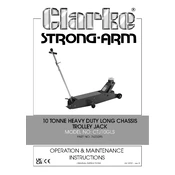Clarke 7623095 CTJ10GLS 10 Tonne Long Chassis Trolley Instructions


The Clarke 7623095 CTJ10GLS has a maximum load capacity of 10 tonnes.
Regular maintenance includes checking hydraulic fluid levels, inspecting for oil leaks, and ensuring that all moving parts are lubricated. Always store the jack in a dry place to prevent rust.
Check for air in the hydraulic system by opening the release valve and pumping the handle several times. Ensure that the hydraulic fluid is at the correct level and inspect for any visible leaks.
To bleed air, open the release valve, pump the handle several times without load, and close the valve. This will help remove trapped air from the hydraulic system.
It is not recommended to use the trolley jack on uneven or soft surfaces as this may compromise stability and safety. Always use it on a hard, level surface.
Check for obstructions or dirt in the pump mechanism and ensure that all pivot points are lubricated. If the problem persists, inspect the hydraulic fluid level.
Always use the jack on a stable surface, do not exceed the rated capacity, and use jack stands for additional support. Regularly inspect the jack for any signs of damage or wear.
It is recommended to use high-quality hydraulic jack oil. Refer to the manual for specific fluid type and specifications.
Hydraulic fluid should be checked frequently and replaced every 12 months or as needed, depending on usage frequency.
The dimensions of the Clarke 7623095 CTJ10GLS trolley jack are designed to accommodate long chassis vehicles, but specific measurements should be confirmed in the product manual.